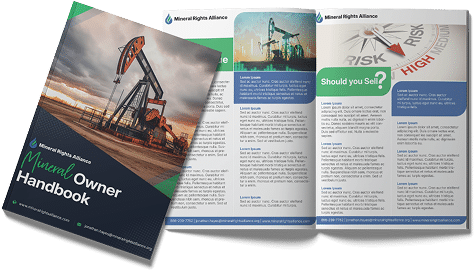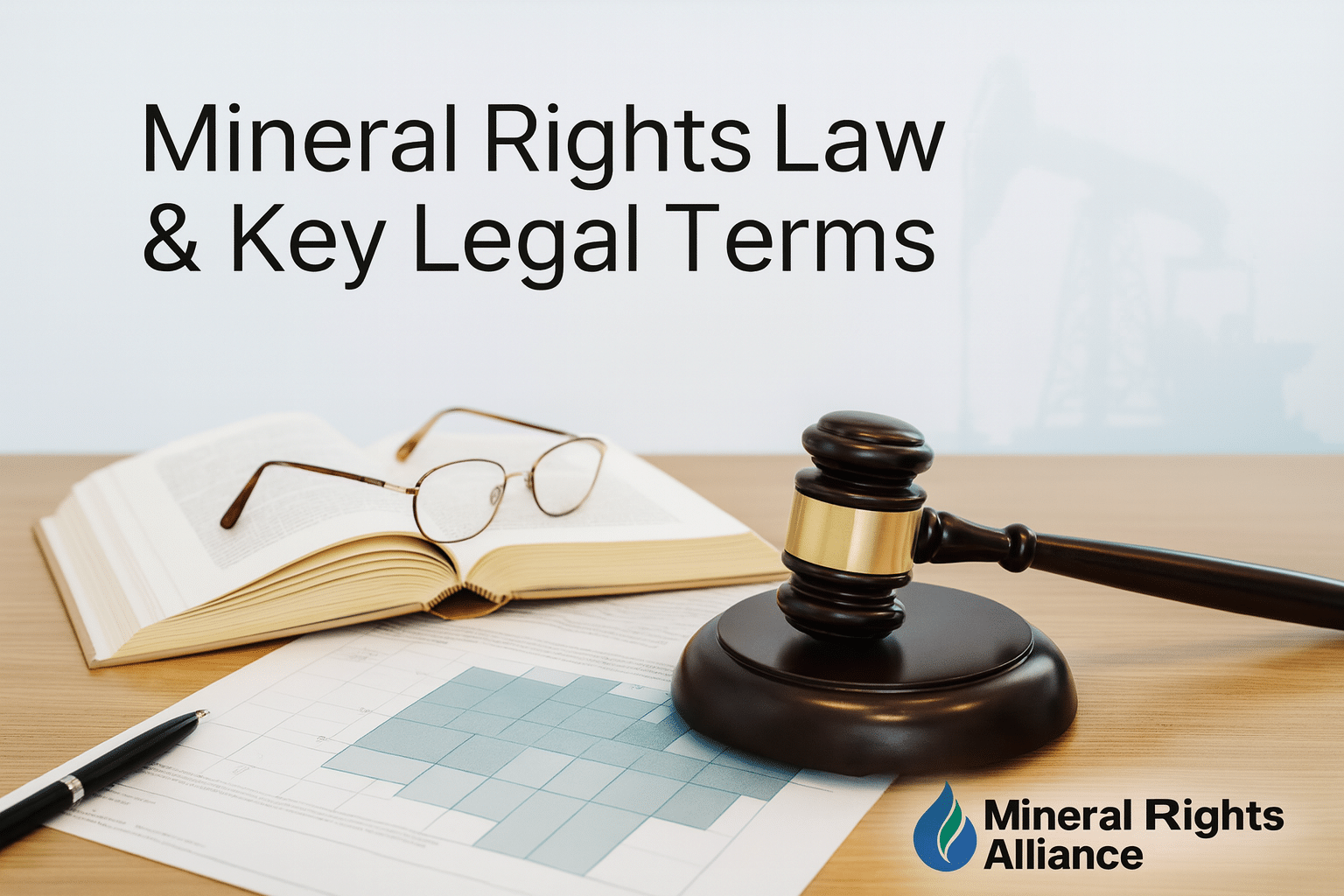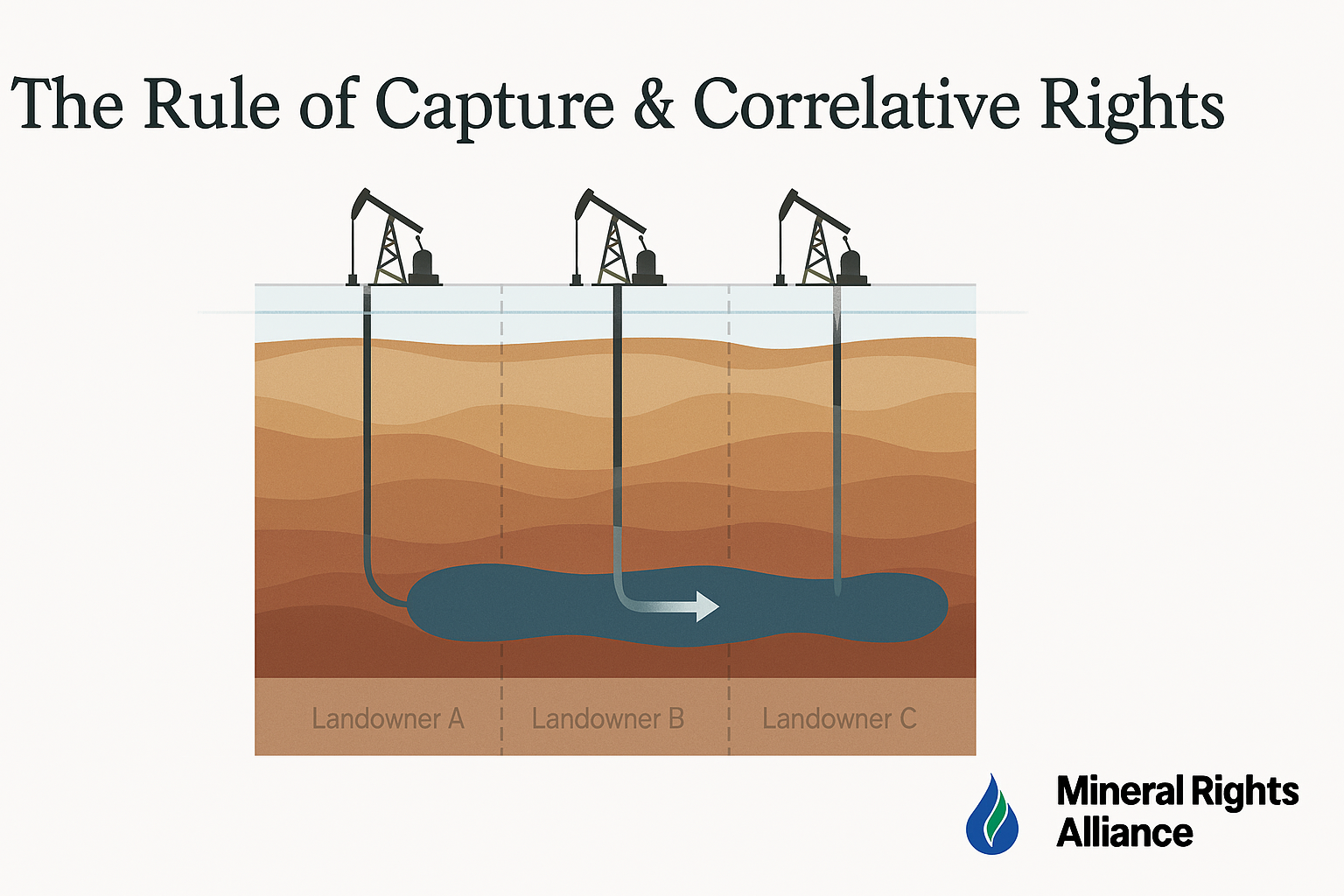Mineral Rights Law & Key Legal Terms
If you own oil and gas mineral rights, or think you might, understanding the legal side of that ownership is important. Many mineral owners are surprised to find out how complicated the laws around mineral rights can be. Between surface rights, leasing language, force pooling, dormant mineral laws, and more, it is easy to feel overwhelmed or unsure of what you actually own.
This guide is here to make things simpler.
We will break down the key legal concepts you need to know as a mineral owner, especially if you are thinking about selling your rights, leasing to an oil company, or negotiating a pipeline or drilling agreement. We will also define the most important terms you are likely to come across and explain them in plain language.
Whether you inherited your minerals, bought land with underlying oil and gas, or just want to protect what you own, this article will help you understand your rights and how to make informed decisions.
Let’s start with the foundation: what mineral rights are and how they can be separated from the surface of your land.
We cover the following topics:
- Understanding Mineral Rights: Ownership, Estates and Severed Interests
- Surface vs. Mineral Estate: Dominance and Reasonable Use
- The Rule of Capture and Correlative Rights
- Oil and Gas Leases: Key Clauses and Legal Terms
- Ownership Interests: Working Interests, Overriding Royalties and Net Revenue Interests
- Legal Instruments: Broad Form Deeds, Surface Use Agreements and Easements
- Statutory Protections and Risk of Losing Mineral Rights
- Bonus: Sheriff’s Sales of Royalty or Mineral Interests in Texas
If you still have questions about mineral rights, contact our company for a free consultation.
Understanding Mineral Rights: Ownership, Estates and Severed Interests
Mineral rights ownership gives someone the legal right to explore, extract, and profit from underground resources like oil, natural gas, or minerals. These rights can exist with the surface land or be completely separate. As a mineral owner, knowing the basics of how mineral rights work can help you protect your property, understand what you own, and make informed decisions when approached with lease or purchase offers.
What Are Mineral Rights?
Mineral rights are considered real property. Just like you can own the surface of a piece of land, you can also own the minerals beneath it. These rights include the ability to lease, sell, inherit, or pass them on. You can also separate them from the surface ownership, and this is where things can get more complex.
When someone owns both the surface and the minerals, it is called a unified estate. This is the simplest situation, where one person controls both the land and what lies beneath it. But many mineral owners today have what is known as a severed estate, where the mineral rights are legally split from the surface rights.
What Is a Severed Estate?
A severed estate occurs when the mineral rights have been sold, transferred, or inherited separately from the land above. For example, you might own the mineral rights under a piece of farmland, even though someone else owns the surface and uses it for crops or cattle.
Severed estates are common in oil and gas producing states like Texas, Oklahoma, New Mexico, and North Dakota. Over generations, landowners often sold or leased the mineral rights while keeping the surface. In some cases, people inherit mineral rights without even realizing it until contacted by an oil company.
Surface vs. Mineral Ownership
When mineral rights are severed, the two estates must work together, but they are not equal in legal terms. In most states, the mineral estate is considered the dominant estate. This means the mineral owner (or an operator with a lease) has the right to access the surface in a reasonable way to explore or produce oil and gas.
Surface owners still have rights, but they cannot block development if the mineral owner is acting within the law. However, operators must avoid unnecessary damage and often negotiate surface use agreements to minimize conflict.
Read how federal mineral rights are managed by the Bureau of Land Management.
Why This Matters to You
If you are a mineral owner, you may have the legal right to lease or sell your rights, even if you do not own the land above. On the other hand, if you own surface land, but not the minerals, oil and gas activity could still happen on your property.
Understanding whether your estate is unified or severed is a key first step. It affects your rights, your income potential, and your ability to negotiate when oil or gas development comes into the picture.
Surface vs. Mineral Estate: Dominance and Reasonable Use
When it comes to oil and gas development, not all property rights are created equal. In most states, the mineral estate is legally considered the “dominant estate.” This means that if the mineral rights have been separated from the surface rights, the mineral owner has the legal right to access the surface in order to explore and produce the minerals.
What Does “Dominant Estate” Really Mean?
In plain terms, the mineral estate has the upper hand. If someone owns the minerals under a piece of land, they have the right to use the surface as reasonably necessary to extract those minerals. This is true even if they do not own the surface land. This legal principle gives oil and gas companies the right to come onto the land to drill, build roads, or set up equipment as long as it is done in a way that is considered reasonable.
However, there are limits. The surface owner does have some protections. The operator cannot cause unnecessary damage or use more of the surface than needed. Courts usually expect a balance between the rights of the mineral owner and the surface owner.
Surface Use Agreements (SUAs)
To help prevent conflicts, many mineral owners and operators sign a Surface Use Agreement. This is a private contract that outlines how the operator will access and use the land. It can include details like road placement, fencing, water usage, cleanup responsibilities, and compensation for surface damage.
If you are a surface owner but do not own the minerals, having a Surface Use Agreement can help you maintain more control over how your land is used during drilling or development.
Why This Matters to Mineral Owners
If you own mineral rights, understanding how and when the surface can be used is critical. You may not plan to drill the land yourself, but an oil or gas company will need to access the surface in order to develop those resources. That access can affect nearby homes, ranching operations, or farming activity.
On the other hand, if you own both the surface and mineral rights, you are in a stronger position. You control both the land and what lies beneath it, which can be helpful when negotiating a lease or sale.
The Rule of Capture and Correlative Rights
When oil and gas companies drill a well, the oil or gas that comes out may not stay directly beneath the surface of the land being drilled. Fluids in underground reservoirs can move, and this movement is at the heart of one of the most important legal concepts in oil and gas law: the Rule of Capture.
What Is the Rule of Capture?
The Rule of Capture is a legal principle that allows a mineral owner to extract oil or gas from a well on their own land, even if that oil or gas migrated from beneath a neighbor’s property. As long as the well is legally drilled and the operator stays within the boundary lines, the production is allowed. This rule encourages development and rewards those who act first.
For mineral owners, this means that if you own the rights and an operator drills on your land, you are entitled to the production—even if some of that oil or gas flowed in from a neighbor’s mineral estate. On the flip side, if a nearby property is drilled first, you could miss out on resources under your own land.
What Are Correlative Rights?
To help balance the Rule of Capture, states have developed laws to protect neighboring mineral owners. These protections are known as correlative rights. Correlative rights make sure that no single mineral owner or operator takes an unfair share of a shared underground reservoir.
In practical terms, this can limit how many wells can be drilled in an area, how close they can be to each other, and how production must be shared. These rules are typically enforced by state oil and gas commissions.
Why These Rules Matter
The Rule of Capture can create a “race to drill,” where the first to act has the advantage. But correlative rights are in place to prevent waste and to ensure that everyone with a stake in the mineral resources is treated fairly.
If you are a mineral owner, understanding these rules helps you see why timing and location matter so much in oil and gas development. It also explains why unitization, pooling, and shared production agreements are common across producing states.
In short, the Rule of Capture rewards action, while correlative rights ensure fairness.
Oil and Gas Leases: Key Clauses and Legal Terms
If you own mineral rights, one of the most important documents you will ever sign is the oil and gas lease. This legal agreement gives an oil company the right to explore for and produce minerals from your land. In return, you receive payment, often in the form of a signing bonus and a royalty on production.
But oil and gas leases are full of legal language. Understanding the key terms in these documents can help you avoid costly mistakes and make sure you are getting a fair deal.
Primary Term and Secondary Term
The primary term is the amount of time the oil company has to begin drilling or developing the minerals. This period is usually three to five years. If no drilling occurs by the end of the primary term, the lease may expire.
The secondary term begins if a well is drilled and producing during the primary term. The lease then stays active as long as production continues.
Bonus, Royalty, and Delay Rental
-
Bonus: A one-time payment made to the mineral owner when the lease is signed.
-
Royalty: A percentage of the revenue from any oil or gas produced. This is typically between 12.5 percent and 25 percent.
-
Delay rental: A yearly payment made by the company if no drilling occurs during the primary term. It allows the company to keep the lease active without drilling.
Pugh Clause
A Pugh clause is important in large tracts of land. It prevents the oil company from holding all your acreage if they only drill on a small portion. Without a Pugh clause, the lease could remain in effect for all your land even if only one well is producing.
Shut-In Royalty
If a well is drilled but not producing for a period of time, the company may pay a shut-in royalty to keep the lease active. This usually happens if there are problems with transportation or market conditions.
Force Majeure
This clause covers unexpected events, like natural disasters or government actions, that might delay drilling or production. It protects the company from being in breach of contract during such events.
Habendum Clause
This clause defines the life of the lease. It usually states that the lease lasts for a set number of years (primary term) and then as long as oil or gas is produced (secondary term).
Division Orders
Once production starts, you will receive a division order. This document outlines your share of the production revenue. You must sign it to start receiving payments.
Ownership Interests: Working Interests, Overriding Royalties, and Net Revenue Interests
When oil and gas are produced from a property, there are often several different parties who have a financial interest in the production. Each of these interests plays a specific role in how money is earned, shared, and managed. If you are a mineral owner, it is important to understand the different types of ownership interests and how they may affect your income.
Working Interest (WI)
A working interest is the share of the oil and gas lease that gives someone the right to explore, drill, and produce. This is usually held by the oil company or operator. It also comes with the responsibility to pay for drilling, production, and operating costs.
Working interest owners take on the most risk because they pay all the expenses. But they also have the highest potential rewards if a well is successful.
Royalty Interest (RI)
As a mineral owner, you typically receive a royalty interest. This is your share of the revenue from production, and it is paid to you without any cost for drilling or operating. It is a percentage agreed upon in your lease, often somewhere between 12.5 and 25 percent of the value of the oil or gas produced.
You do not have to pay any of the costs, but you only receive a portion of the income after some deductions are made.
Overriding Royalty Interest (ORRI)
An overriding royalty interest is a type of royalty that sits on top of the working interest. It is usually given to someone like a geologist, broker, or landman as part of their compensation for helping to make the deal happen. The overriding royalty does not last forever. It usually ends when the lease expires.
This type of interest does not come from mineral ownership. It comes from the lease itself and is carved out of the working interest.
Net Revenue Interest (NRI)
The net revenue interest is the actual percentage of production revenue that a party will receive after royalties and other burdens are deducted. For example, if a working interest owner holds 100 percent of the working interest but has to pay a 20 percent royalty to the mineral owner, the net revenue interest would be 80 percent.
For mineral owners, it helps to understand that while you may see 100 percent ownership of the minerals on paper, you are likely only entitled to the royalty portion as defined in the lease.
Knowing the difference between these types of interests can help you better understand how revenue from a producing well is divided. It also helps protect you from confusion or disputes when signing a lease, reviewing a division order, or considering a sale of your mineral rights.
Legal Instruments: Broad Form Deeds, Surface Use Agreements, and Easements
Mineral rights are often passed down, sold, or leased using legal documents called instruments. These documents are what legally define ownership, access, and usage. If you own mineral rights or surface rights, it is helpful to understand the most common types of legal instruments and what they mean for you.
Broad Form Deeds
A broad form deed is a type of deed that gives very wide rights to the mineral owner or the operator who leases those rights. These deeds were commonly used in the early 1900s, especially in Texas and Oklahoma.
Under a broad form deed, the mineral rights owner has the power to use the surface in almost any way necessary to explore and extract oil, gas, or minerals. This includes building roads, using water, digging pits, and more. These rights were often so broad that they created serious conflicts between mineral owners and surface owners.
Today, courts in some states have placed limits on how much surface damage is allowed under broad form deeds. But if you have an old deed like this in your chain of title, it may still give the mineral owner strong rights to use the land.
Surface Use Agreements (SUAs)
A Surface Use Agreement is a private contract between the surface owner and the oil or gas operator. It sets rules for how the surface can be used during development. This may include road placement, location of equipment, water use, noise control, and payments for damages.
Even if the mineral rights owner or operator has the legal right to use the surface, a Surface Use Agreement helps avoid misunderstandings and provides clear terms everyone agrees to in writing.
If you are a surface owner, an SUA can help protect your land and your peace of mind. If you are a mineral owner and also own the surface, it gives you more control over how drilling or production happens on your property.
Easements and Right-of-Way Agreements
An easement is a legal right to use part of someone else’s land for a specific purpose. In oil and gas development, this often means a pipeline easement or a right-of-way agreement. These agreements allow a company to run pipelines, roads, or power lines across a property.
If you are negotiating an easement, make sure the agreement clearly defines the width, location, payment, and responsibilities for maintenance and restoration. Easements can be temporary or permanent, and they often stay attached to the land, even if the property is sold.
Final Thoughts
These legal instruments can affect your property for generations. Whether you are reviewing an old deed, signing a new lease, or negotiating a pipeline agreement, it is important to read carefully and seek legal advice if you are unsure. The terms you agree to today can impact your land and income for many years to come.
Statutory Protections and Risk of Losing Mineral Rights
Many mineral owners are surprised to learn that under certain circumstances, it is possible to lose your mineral rights. Each state has its own set of laws designed to manage unused mineral interests and make sure ownership is properly recorded. These laws are meant to protect mineral resources, but they can also lead to the loss of rights if owners are not careful.
Dormant Mineral Acts
Some states have passed laws called Dormant Mineral Acts. These laws are designed to clear up old or inactive mineral rights that have not been used or claimed for a long time. If you own mineral rights but have not actively used them or recorded your ownership, you could risk losing them under one of these acts.
In general, a Dormant Mineral Act allows surface owners to claim ownership of mineral rights that have been inactive for a certain number of years. The exact number of years and rules vary by state. For example, in some states, if no activity or recording has occurred in 20 years, the mineral rights can be considered abandoned.
To protect your rights, it is important to either lease your minerals or file a statement of claim in the county records. This creates a public record that helps preserve your ownership.
Recording Requirements
In many states, simply owning mineral rights is not enough. You may need to record your interest in the local courthouse to protect your claim. Without proper documentation, it can become difficult to prove ownership, especially if the rights have been passed down through generations.
If your mineral rights were inherited, it is a good idea to record a deed or affidavit of heirship. If you purchased mineral rights, make sure the deed is filed correctly in the county where the minerals are located.
Keeping records up to date is one of the most effective ways to protect your rights from being lost or challenged.
Implied Abandonment and Non-Use
Even in states without formal Dormant Mineral Acts, courts can sometimes declare that mineral rights have been abandoned. This usually happens when the owner has not leased, developed, or transferred the rights for a very long time and cannot be located. This concept is called implied abandonment.
While not as common as other legal threats, implied abandonment can still be a risk if ownership records are unclear or if rights have not been used for many decades.
Why This Matters to Mineral Owners
If you are thinking about selling or leasing your mineral rights, one of the first things a buyer or operator will check is whether your title is clean and properly recorded. If there are gaps in the record, it could lower the value of your rights or delay a transaction.
Taking simple steps like recording your ownership, reviewing old deeds, and leasing your rights when opportunities arise can go a long way in protecting your interests.
Bonus: Sheriff’s Sales of Royalty or Mineral Interests in Texas
In Texas, if someone fails to pay property taxes, the county can hold a sheriff’s sale to recover the debt. This process may include real estate and sometimes royalty or working interests, but not the underlying mineral rights themselves.
What Is Typically Sold
Only taxable interests can be foreclosed. While mineral rights are considered real property, they often carry no assessed value for tax purposes. Instead, the interests that are commonly taxed and sold at a sheriff’s sale are royalty interests, working interests, or overriding royalty interests.
This means that a sheriff’s deed will typically transfer only the specific interest that was taxed. It does not include full ownership of the mineral estate or the surface land.
Redemption Period After Sale
Texas law gives the original owner a period of time to redeem the property after the sheriff’s sale. For royalty or producing interests, this redemption period can last up to two years.
If the owner redeems the interest in the first year, they may be required to pay a penalty of up to 25 percent of the purchase price. If the redemption happens in the second year, the penalty can be as high as 50 percent.
Once this redemption period ends, full ownership transfers to the buyer.
What Buyers Should Do
If you buy mineral rights at a sheriff’s sale, you should take a few important steps:
-
Notify the operator immediately so that future payments can be transferred to you once the redemption period ends.
-
Understand that you are only entitled to production that occurs after the redemption window closes. Royalties from before the sale typically remain with the original owner or are handled through the state’s unclaimed property system.
Why This Matters to Mineral Owners
If you own mineral rights, it is important to know that missing tax payments on related interests could result in a sheriff’s sale. However, only production-related interests are at risk, not the actual mineral rights.
Mineral and surface rights usually stay intact, but producing interests like royalties can be sold if taxes go unpaid. This makes it important to track your tax obligations and make sure ownership records are up to date.
Buyers should always verify what is being sold and understand the timeline for when payments can begin. A sheriff’s sale can be an opportunity, but only if the buyer knows exactly what they are purchasing.
Questions about Mineral Rights?
If you have questions about oil and gas royalties, reach out to Mineral Rights Alliance for a free consultation.
Whether you’re thinking about selling, leasing, or just want to understand what you own, we’re here to help. Contact us today for a free consultation with a mineral rights expert.





